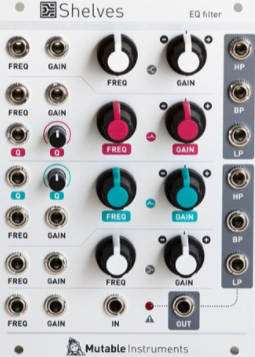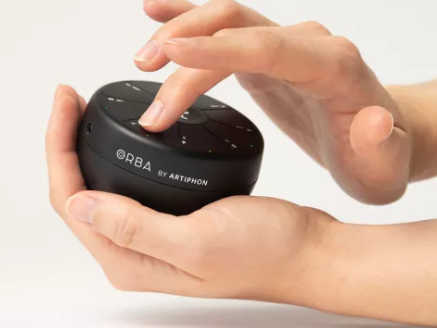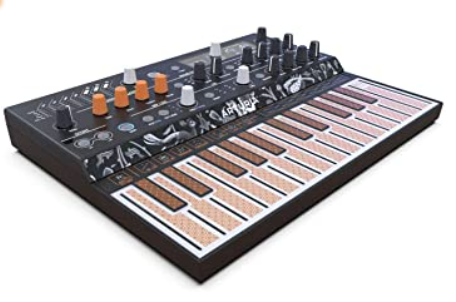
Mutable Instruments Shelves arrived over the weekend to fill out the biggest remaining gap in the modular. It’s a shelving and peaking EQ, where each band has a full frequency range available and its frequency, gain and Q can be voltage controlled. The two peak EQ bands are implemented using filters, and have lowpass, bandpass and highpass outputs as well. So it’s quite a versatile piece of gear. Some of the things it’s good for:
- Basic EQ tasks. However, the available boost and cut isn’t as strong as I might want for some purposes, and it would make more sense to just use CraveEQ or Toneboosters EQ4 for that.
- Feedback loops. A little Q and positive gain, and it will resonate nicely inside of a feedback loop. It’s particularly great with delays, and with MSLR to maintain the tone while keeping it from getting out of hand.
- CV-controlled EQ can be awfully fun. Taking a notch filter (or two) with a gentle slope and sweeping its frequency around with an LFO is a nice bit of (possibly) subtle modulation. With a bit more Q it’ll do filter sweep-like sounds without actually cutting anything completely; to me the character is more interesting than most filter sweeps tend to be.
- Anything a normal filter can do. It sounds pretty respectable to just use one of the LP, BP, or HP outputs with it.
- Parallel filter trickery. It does only have one input, but with two independent filters, each of which has three outputs, plus the main EQ output, I can turn a mono signal into mid-side stereo, process different bands with different effects and mix them afterward, or split bands to go into Planar.
I don’t see much reason to hang onto FXDf, or even Ripples now. Once I figure out what I will replace them with, I’ll pull them out. I have a few candidates in mind but none are really pulling on the strings strong enough yet to jump on it. Loquelic Iteritas or Telharmonic would certainly be interesting but do I need another oscillator? Intellijel Bifold seems like a quite good wavefolder, but between the folder on Shapeshifter, FM Aid’s folding abilities. the folder built into ENOSC and rather capable wavefolding available in both Disting and Bitwig, I’m not convinced I need it.

The other toy I’ve taken delivery of is… well, it is kind of a toy, but it’s also got some surprising instrument-like features, and the combination is a bit frustrating. The Artiphon Orba, which I Kickstarted back last December, is a little handheld musical gizmo. It has 8 pads that respond to velocity as well as movement on two axes (for pitch bend or dynamics), and an accelerometer to detect tilting, shaking, and slapping the side. It has four “modes” — drums, bass, chord and lead — and a record mode that records sequences on each channel, with overdubbing. It can also act as a MIDI controller (with MPE!) over USB or Bluetooth. It’s got a pretty decent built-in speaker with ports both on the bottom and sides so it’s not muffled no matter how you position it.
On the down side: onboard, it has only one sound per mode; you can select from about 7 different sounds using an app that updates the device over its connection. Many of the sounds are just not great, but it’s got a few relative winners. Sometimes there are unpleasant pops at the start of notes, and switching modes while trying to record parts can pause and silence the whole thing for a second or two. The recorder doesn’t seem to record tilt gestures. Octave switching is a pain, and often results in accidentally switching modes instead; you can forget doing it smoothly while playing to extend the usable range. The built-in speaker is plenty loud (a little too much with some of the lead sounds in their higher octave) but the output jack is so woefully low level that I boosted it with both Gozinta and MSCL. The PC app is as buggy as Florida in July, and the Android version is nonexistent (typical of every Kickstarter device I’ve seen that promised both Android and iOS support).
So, as an instrument in its own right, it’s mostly a fun toy — for a beginner, generally easier to jam on and get something that sounds moderately okay than a Casio keyboard or the like. But how about as a MIDI controller for more serious efforts? Let’s start with Bluetooth MIDI being unsupported in Windows, which they could have fixed with the app or a driver but didn’t, so it’s tethered with a USB cable. You can’t change the scales assigned to each mode — so the bass is always major, the lead is always pentatonic major, and the chords are fixed (depending on which sound you’ve loaded). As far as I can tell so far, it sends velocity, mod wheel on tilt, and it probably sends MPE on the two axes per pad. There is apparently a third-party semi-unofficial app for MIDI configuration, which I hope can unlock the thing’s potential a bit more. But it won’t surprise me if it remains mostly a toy, which I might sample occasionally with Phonogene or freeze in Clouds or Mimeophon, after a copious gain boost that is.
But hey, it lets me have the fun of doing some idle finger drumming, which I haven’t done since switching from Maschine to Bitwig, or playing some honestly kind of nifty growly drones with the “Ohm” bass sound.

The next bit of gear should arrive Friday: I picked up an Arturia Microfreak in a Labor Day sale. I disdained it when it was released, and wasn’t sure I liked the touch keyboard when I very briefly stabbed at it at Knobcon last year — but I have heard so many good things about it, and good things people have done with it, that I’m willing to give it a solid try. If it works out, it will replace my Reface CS, which has been seeing less and less action.
The CS is fun to jam with but it can be a little difficult to make it relevant to what I want to do. The wee Freak though is mostly a polyphonic version of Plaits, plus an SEM filter and a touchplate pressure keyboard — and I know from the 0-Ctrl that I do like a touchplate pressure keyboard when it works well — and a neat little arpeggiator/sequencer that can dynamically randomize its content in a way that tickles my generative sequencing funny bone, and also record parameter automation. So that could potentially be quite nifty. Given that used prices are hovering very close to new prices, it is practically zero risk if I don’t like the thing after all.
Something else I have been thinking about is the Elektron Model:Cycles. I ignored it when it was announced, because it’s an Elektron groovebox, kind of a glorified drum machine, and I don’t do the sort of music that uses drum machines. Except… it’s really an inexpensive little FM synth, and there’s apparently a small community that swears it was secretly made for ambient music. Its FM is definitely more on the pure and simple side, being modern and clean and 2-operator based — but you layer that a bit and it really can sound gorgeous. I’ll have room for it in my setup if the Freak takes over from the CS, but it would eat into my available inputs. Also I can’t help but think it won’t really do anything I can’t do with Bitwig’s FM-4 instrument, aside from maybe inspire me to use it more often. (The Microfreak itself also has an FM mode…) So I’m gonna have to think on that more. I might be better off with something that has some crust on it, like an old FB-01 (cheap, but requires software to edit it without going crazy) or a MegaFM (less cheap, would probably have to take over from the Lyra-8) or a Volca FM (cheap, can also control and sequence itself, and can play 6-op DX7 sounds yet has a few hands-on controls to tweak it). Or just not make any of those moves at all.
I had a thought about what I could do for the next album, but it’s a little out of my comfort zone: record patch-from-scratch sessions and see if I can make it an actual performance. It will probably require a lot of trying and there will probably be many times where I’ve got a boring and ugly first minute, then some really sweet sounding awesomeness, and then it kind of falls apart or gets ruined with a sudden blast of noise as I try to add another voice. I really admire the people who can do this as a show, but I’m sure there is some preparation and practice involved. Still, it could be fun and rewarding to try it…
